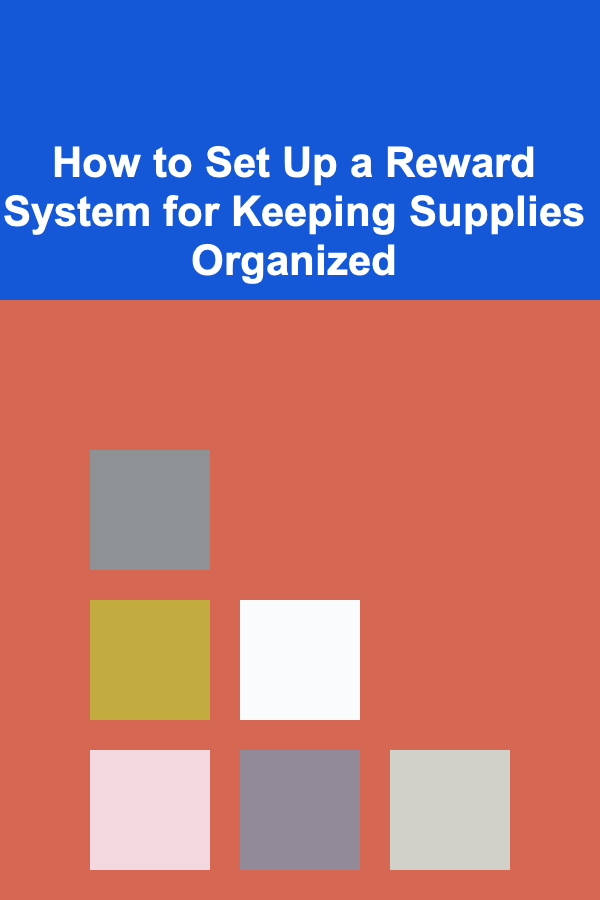
How to Set Up a Reward System for Keeping Supplies Organized
ebook include PDF & Audio bundle (Micro Guide)
$12.99$8.99
Limited Time Offer! Order within the next:

Establishing a reward system can be an effective way to encourage children and family members to keep their supplies organized. A well-structured reward system not only promotes good organizational habits but also reinforces positive behavior through motivation and reinforcement. In this comprehensive guide, we will explore how to set up an effective reward system, its benefits, strategies for implementation, and tips for maintaining long-term engagement.
Introduction
Organizing supplies---whether they belong to school, crafts, or home offices---can often become a daunting task. Children and adults alike may overlook the importance of keeping their materials tidy, leading to increased frustration, wasted time, and chaotic environments. However, by implementing a reward system, you can foster a culture of organization that encourages everyone to take responsibility for their belongings.
This guide aims to provide a detailed roadmap for setting up a reward system tailored to encouraging organization and responsibility among family members. Through clearly defined goals, engaging rewards, and effective tracking methods, you can create a nurturing environment that values orderliness.
Understanding the Importance of Organization
Before diving into how to set up a reward system, it is essential to grasp why organization is crucial in various settings:
- Improved Efficiency: An organized space allows individuals to find what they need quickly, reducing time wasted on searching for items.
- Reduced Stress: Clutter can lead to feelings of overwhelm. An organized environment fosters calmness and focus.
- Promotes Responsibility: When individuals are encouraged to take care of their supplies, they develop a sense of accountability for their actions.
- Better Productivity: An orderly workspace enhances concentration and productivity, contributing to overall success in school and personal projects.
- Encourages Good Habits: Instilling organizational habits from a young age sets the foundation for lifelong skills that extend beyond school.
Defining Your Goals
When establishing a reward system, it's critical to define specific, measurable goals. Here are some steps to consider:
1. Identify Key Areas of Organization
Determine which supplies or areas require the most attention. This could include:
- School supplies (notebooks, pens, folders)
- Art and craft materials
- Home office equipment
- General household items
2. Set Clear Objectives
Define what successful organization looks like for each area. For example:
- All school supplies should be stored in designated bins.
- Craft materials must be sorted by type (paints, brushes, paper).
- Homework areas should be kept clutter-free and ready for use.
3. Establish Time Frames
Decide how often you want to review progress. Consider weekly or monthly check-ins to assess organization levels and award points or rewards based on achievements.
Designing the Reward System
A well-designed reward system requires careful consideration of types of rewards, clear expectations, and tracking methods.
4.1 Types of Rewards
Choosing appropriate rewards is pivotal. Here are some options:
A. Tangible Rewards
These are physical items that can be given when certain organizational goals are met. Examples include:
- Stickers or stamps for younger children
- Small toys or books
- Crafts materials or art supplies
B. Experiential Rewards
Consider offering experiences instead of material items. This can include:
- Movie nights
- Special outings (zoo, museum, amusement park)
- Extra free time for a favored activity (video games, reading)
C. Privileges
Rewards can also involve the granting of privileges. For example:
- Choosing a family dinner menu
- Staying up late on weekends
- Selecting a weekend activity
4.2 Setting Clear Expectations
It's important to communicate what is expected for family members to earn rewards:
A. Create a Reward Chart
Visual representation is powerful. Design a chart where family members can track their progress toward achieving their organizational goals. This can include points earned for completing tasks or reaching milestones.
B. Clearly Outline Criteria
Specify what behaviors or achievements will warrant rewards. For example:
- Organizing supplies every Sunday earns one point.
- Maintaining a clutter-free desk for a week earns three points.
- Completing assigned chores related to organization earns bonus points.
Implementing the System
Once the framework for the reward system is established, it's time to implement it effectively.
5.1 Involving Family Members
Engagement from all family members is key to the success of the program.
A. Family Meetings
Hold a family meeting to discuss the new system. Explain the reasons behind it, how it will work, and what everyone stands to gain.
B. Encourage Input
Allow family members to share their thoughts on potential rewards and organizational goals. This input fosters ownership and buy-in from participants.
5.2 Creating a Visual Tracker
Visual trackers help maintain clarity and motivation:
A. Reward Charts
Develop charts that are displayed prominently in the house. Use colorful markers and stickers to make them visually appealing.
B. Digital Options
If preferred, consider using apps or online platforms designed for tracking rewards and goals. This can be particularly engaging for tech-savvy family members.
Maintaining Engagement
Keeping everyone motivated is crucial for the longevity of your reward system.
6.1 Regular Reviews
Conduct regular reviews to assess progress and adjust the system as needed:
A. Weekly Check-Ins
Set aside time each week to evaluate successes and setbacks. Discuss what went well and what could improve.
B. Celebrate Achievements
When rewards are earned, celebrate achievements together. This could be as simple as a 'high-five' or hosting a small celebration.
6.2 Adapting the System
Flexibility is essential for responsiveness to the needs and preferences of family members:
A. Experiment with Rewards
Try varying the types of rewards periodically to keep things fresh and exciting. If something isn't working, don't hesitate to make adjustments.
B. Reassess Goals
As organizational behaviors develop, update goals to reflect new challenges. Including more advanced tasks can keep family members engaged.
Common Challenges and Solutions
Even with a solid plan, challenges may arise. Here are some common issues and how to tackle them:
1. Lack of Motivation
Challenge: Family members may lose interest in the reward system over time.
Solution: Introduce new rewards regularly and emphasize the benefits of being organized. Refreshing goals and making them more challenging can reignite interest.
2. Inconsistent Participation
Challenge: Not every family member may engage equally in the system.
Solution: Ensure clear communication about responsibilities and encourage each person to set their own goals. Celebrate individual achievements to boost morale.
3. Difficulty Tracking Progress
Challenge: Tracking progress might become cumbersome.
Solution: Streamline the tracking process by simplifying charts or using digital tools that notify users about their status. Frequent updates can make managing progress easier.
4. Resistance to Change
Challenge: Some family members may resist altering their current habits.
Solution: Clearly explain the benefits of organization and involve them in the planning process. Transition gradually, providing support during the adjustment period.
Conclusion
Establishing a reward system for keeping supplies organized is a proactive approach to fostering responsibility and good habits within the family. By defining clear goals, designing an engaging reward system, and maintaining consistent participation, you can create an environment that values organization and efficiency.
This guide serves as a comprehensive roadmap to developing a rewarding experience for everyone involved. With commitment and creativity, you can significantly enhance the organization of supplies at home while fostering a sense of achievement and independence among family members. Embrace the journey of organization, and watch your family's habits flourish!
Reading More From Our Other Websites
- [Home Cleaning 101] Best Eco‑Friendly Home Cleaning Routine for Families with Young Children
- [Organization Tip 101] How to Plan Meals for Your Trip to Save Money
- [Home Staging 101] How to Make Your Home Look Bigger and Brighter with Staging
- [Skydiving Tip 101] Fitness & Nutrition Tips to Boost Your Skydiving Performance
- [Reading Habit Tip 101] DIY Digital Libraries: Setting Up Your Own Budget E-Book Collection
- [Home Pet Care 101] How to Use Pet Technology for Better Care
- [Home Lighting 101] How to Use Task Lighting in Your Home for Better Functionality
- [Trail Running Tip 101] Top 10 Scenic Trail Running Routes to Explore Near You
- [Whitewater Rafting Tip 101] Paddling Toward Positivity: How Group Rafting Elevates Mental Well‑Being
- [Personal Investment 101] How to Build a Profitable AI Business with Deep Learning

How To Plan Your First Overnight Backpacking Trip
Read More
How to Secure Sliding Glass Doors and Windows Effectively
Read More
How to Sell Homemade Organic Skincare Products on Etsy: An Actionable Guide
Read More
How to Use Tiered Organizers for Small Beauty Items
Read More
Pharmacist's Companion: Navigating the Complexities of Pharmaceutical Management
Read More
How to Train for a Spartan Race (or Obstacle Course)
Read MoreOther Products

How To Plan Your First Overnight Backpacking Trip
Read More
How to Secure Sliding Glass Doors and Windows Effectively
Read More
How to Sell Homemade Organic Skincare Products on Etsy: An Actionable Guide
Read More
How to Use Tiered Organizers for Small Beauty Items
Read More
Pharmacist's Companion: Navigating the Complexities of Pharmaceutical Management
Read More